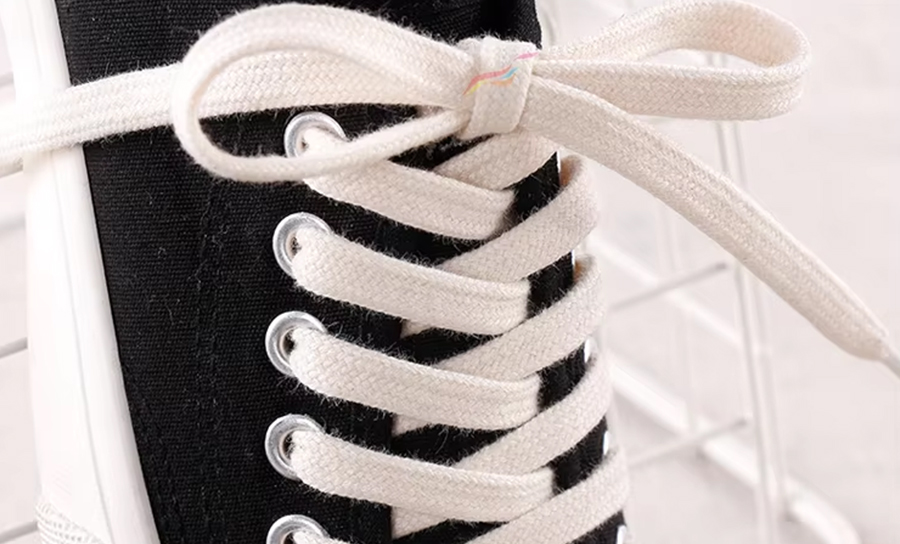Woven fabrics are ubiquitous and indispensable in the textile industry. They are used in a variety of shapes and materials in the clothing industry, home decoration, and some industrial industries. In this article, we will take a deep look at the types, characteristics, and various applications of woven fabrics.

What is weaving?
Braiding is a unique craft technology. Three or more strands of yarn are braided together using a braiding machine to form a flat or tubular rope structure. Different from traditional knitting, braiding technology is mainly used in shoelaces, drawcords, webbing, etc. It can weave a variety of unique textures and appearances with a variety of styles. In particular, you can directly weave the pattern or logo you want on it, which is very simple and efficient.
Types of woven fabrics
According to the shape and structural characteristics of woven fabrics, common types can be roughly divided into two categories:
1. Circular woven fabrics
Circular braids are cylindrical and can be imagined as three-dimensional. Circular braids can be hollow or solid, and the core can be made of different yarns. Circular braids are more commonly used in shoelaces, hat straps, ropes, cables and various industrial applications.

2. Flat woven fabrics
Flat woven fabrics are mainly flat in appearance, equivalent to a two-dimensional form. They are mostly made into shoelaces, webbing, and home furnishing trims.

Material types of woven fabrics
There are many kinds of materials for woven fabrics. You can choose the corresponding materials according to different products. The main materials on the market include the following:
1. Natural fiber
Natural fiber is a textile fiber (animal fiber and plant fiber) obtained directly. It is the most commonly used material type in the textile industry. Therefore, its output is the largest, accounting for about 60% of the market. The common ones mainly include the following:
- Cotton:The biggest feature of cotton cloth is good moisture absorption and breathability. It is the preferred material for underwear and baby clothes.
- Linen:Among natural fibers, linen has the best stretchability, so it is suitable for making clothes and supplies that need to bear force.
- Silk: It is an excellent textile raw material, feels smooth and comfortable, and also has health care functions. The material is relatively unique and suitable for the production of underwear.
- Bamboo fiber: It is a renewable resource, so it is an environmentally friendly material. At the same time, it has unique functions such as antibacterial, anti-mite, anti-odor, and anti-insect, especially suitable for underwear materials in summer.
- Wool fiber:It is generally a material obtained from animals, with strong warmth retention, and is usually used to make winter sweaters, coats, etc.

2. Synthetic fiber
Synthetic fibers are fibers that are artificially synthesized by chemical means. Due to their high strength and strong wear resistance, they are also widely used, accounting for about 25% of the market. The common ones are mainly the following:
- Nylon:It is a polymer material with high strength and high wear resistance. It is generally used to make durable clothes or outdoor equipment.
- Polyester fiber (polyester):Polyester is easy to obtain, so it has a wide range of uses, and the price is relatively affordable. It has good elasticity and is easy to clean. It is generally used in sportswear.
- Spandex:It is an elastic fiber with good elasticity. It can quickly return to its original shape after stretching. Therefore, it is mostly used in elastic bands and mechanical stretch bands, and is particularly popular in the fitness industry.

3. Special materials
In addition to the conventional materials mentioned above, some special materials also bring more possibilities to the weaving industry. These materials only account for about 15% of the market, including:
- Natural grass rattan: durable and environmentally friendly, it can be naturally integrated into a part of the clothing through the weaving process, making it more unique.
- Carbon fiber:It is a new type of fiber material. Its high temperature resistance is the first among all chemical fiber materials. It is usually used to make high-end products, such as mountaineering clothes and radiation protection clothes.

Characteristics of woven fabrics
- Interlaced weaving:Multiple strands of yarn are woven together, which is relatively tight and can make the woven fabric stronger and more durable.
- Various shapes:Different weaving methods and different materials can be combined to weave woven fabrics of different shapes and patterns.
- Strong breathability:Woven fabrics have gaps, so its breathability is unquestionable, and it can also ensure moisture absorption.
- Flexibility:Woven fabrics have good elasticity and are easy to restore to their original shape, which can be used for various purposes.
Application of woven fabrics
The most widely used industry for woven fabrics is the clothing accessories industry, but its application range is extremely wide, and it can be said to be everywhere. It is generally used in the following industries:
- Clothing and accessories industry:shoelaces, webbing, elastic bands, belts, lanyards, decorative edges.
- Home decoration:curtain trims, curtain drawstrings.
- Outdoor equipment: outdoor drawstrings, climbing ropes.
- Industrial applications: cable ropes, parachutes, fishing rods.

Summarize
Through the detailed description in this article, have you already had a comprehensive understanding of the types, characteristics and applications of woven fabrics? Each type of woven fabric has its unique advantages and functions. You can choose the woven fabric that is more suitable for you according to the guide.
FAQ
Is woven fabric suitable for outdoor use?
Yes, synthetic fiber materials can be used to weave outdoor ropes with relatively strong hardness and durability.
How to maintain and clean woven fabrics?
Just follow the instructions on the label. In most cases, regular washing is sufficient, and avoid direct sunlight and frequent friction.




